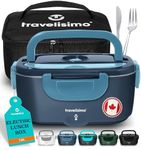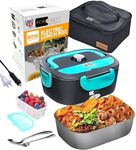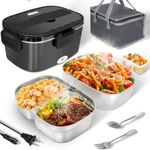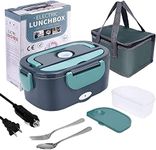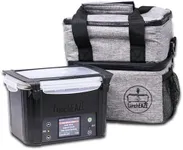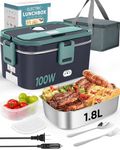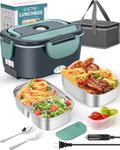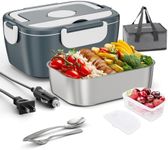Buying Guide for the Best Electric Lunch Boxes
Choosing the right electric lunch box can make your meals on the go much more enjoyable and convenient. The main goal is to find a lunch box that keeps your food warm, is easy to use, and fits your lifestyle. Before buying, think about where and how you’ll use it—at work, school, or while traveling. Consider the size of your meals, how easy it is to clean, and whether you need extra features like multiple compartments or car charging options. Understanding the key features will help you pick a lunch box that matches your daily needs and makes your meal times hassle-free.CapacityCapacity refers to how much food the lunch box can hold, usually measured in milliliters or liters. This is important because it determines whether you can fit a full meal or just a snack. Smaller capacities (around 500-700ml) are good for light eaters or snacks, while medium sizes (700-1000ml) suit most standard lunches. Larger capacities (over 1000ml) are best for those with bigger appetites or who want to pack multiple dishes. To pick the right one, think about your typical meal size and whether you want to carry extra items like fruit or salad.
Heating MethodThe heating method describes how the lunch box warms your food, usually through electric heating plates or steam. This matters because it affects how evenly and quickly your food heats up. Some boxes heat directly, while others use water to create steam. Direct heating is faster but may dry out food, while steam heating is gentler and keeps food moist. If you prefer quick heating, direct methods are suitable, but for delicate foods or if you want to avoid drying, steam-based options are better. Consider what types of meals you usually bring and how you like them reheated.
Power SourcePower source indicates how the lunch box is powered—most commonly through a wall plug (AC), car adapter (DC), or both. This is important for flexibility. AC-powered boxes are great for office or home use, while DC-powered ones are ideal for cars and travel. Some models offer both, giving you more options. Choose based on where you plan to use your lunch box most often. If you commute by car, a DC option is helpful; if you’re mostly at a desk, AC is sufficient.
MaterialMaterial refers to what the lunch box and its inner containers are made of, such as stainless steel, plastic, or a combination. This affects durability, safety, and ease of cleaning. Stainless steel is sturdy, easy to clean, and doesn’t retain odors, making it a good choice for regular use. Plastic is lighter and often cheaper, but may stain or absorb smells over time. If you want something long-lasting and easy to maintain, go for stainless steel interiors. For lighter weight and portability, plastic may be better, but check for food-grade, BPA-free materials.
Ease of CleaningEase of cleaning is about how simple it is to wash the lunch box after use. Some have removable containers or dishwasher-safe parts, while others require hand washing. This is important for hygiene and convenience. Removable, dishwasher-safe containers make cleaning quick and easy, especially if you use the lunch box daily. If you don’t mind hand washing, you have more options, but always check if the design has hard-to-reach corners. Choose a model that matches your cleaning habits and time available for maintenance.
CompartmentsCompartments refer to the number of separate sections inside the lunch box for different foods. This matters if you like to keep foods separate, such as rice and curry or salad and main dish. Single-compartment boxes are simple and good for one-dish meals, while multiple compartments help organize a variety of foods and prevent mixing. If you enjoy variety in your meals or want to avoid flavors blending, look for a lunch box with two or more compartments. If you usually pack one type of food, a single compartment is enough.
PortabilityPortability covers the size, weight, and design features like handles or carrying bags that make the lunch box easy to transport. This is important if you carry your lunch box daily or over long distances. Lightweight, compact models are easier to carry, while larger ones may be bulkier but hold more food. Handles and carrying cases add convenience. Think about your daily routine—if you walk or commute a lot, a lighter, more portable lunch box is best. If you drive or don’t move much, size and weight are less of a concern.
